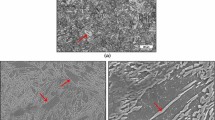Conclusions
-
1.
To ensure fairly high resistance of weldments to cracking during heating of precipitation-hardening alloys it is necessary to have high plasticity at aging temperatures.
-
2.
Alloy KhN63M9B2Yu was developed for welded structures operating at temperatures from −253 to +750° C. The alloy has a fairly high resistance to cracking during welding or during subsequent heat treatment.
Similar content being viewed by others
Literature cited
L. N. Simina et al., Metal. i Term. Obrabotka Metal., No. 3 (1969).
E. E. Levin and B. M. Gugelev, Metal. i Term. Obrabotka Metal., No. 1 (1967).
Additional information
Translated from Metallovedenie i Termicheskaya Obrabotka metallov, No. 10, pp. 20–23, October, 1971.
Rights and permissions
About this article
Cite this article
Sorokina, N.A., Ul'yanin, E.A., Tashchilov, V.S. et al. Structure and properties of nickel alloys for cryogenic applications. Met Sci Heat Treat 13, 823–826 (1971). https://doi.org/10.1007/BF00713815
Issue Date:
DOI: https://doi.org/10.1007/BF00713815




